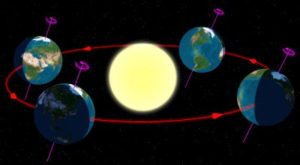Seasons are periods during the Earth’s solar year when the weather patterns are mostly the same because temperatures stay in the same ranges across most of the planet. Our plants and some animals have adapted to the changes in seasons through long eons of evolution.
A solar year is the length of time it takes the Earth to complete one orbit around the sun. Although you might imagine this orbital path to be a circle it is really an ellipse. The elliptical nature of the Earth’s orbit means that it has a point where it is closer to the sun than at any other time in the solar year. This is called perihelion. There is also a point where the Earth is farthest from the sun. That is called aphelion.
 Objects have elliptical orbits around stars because the forces of gravity are fighting with the forces of inertia. When the planets and asteroids first formed they were following circular orbits. But as debris crashed into larger bodies they were slowly jolted from their original orbits. Also, the gravity of the planets, asteroids, and comets pulls gently at all the objects orbiting the sun. So the once circular orbits have been changed over billions of years.
Objects have elliptical orbits around stars because the forces of gravity are fighting with the forces of inertia. When the planets and asteroids first formed they were following circular orbits. But as debris crashed into larger bodies they were slowly jolted from their original orbits. Also, the gravity of the planets, asteroids, and comets pulls gently at all the objects orbiting the sun. So the once circular orbits have been changed over billions of years.
These elliptical orbits mean that Earth and other objects move faster when they are closest to the sun and slower when they are farthest from the sun. The perhelion seasons are thus a little shorter than the aphelion seasons.
But there is one other thing that contributes to the changes we call seasons: the Earth’s angle of rotation. This is also called the Earth’s tilt.
The sun is a rotating body. Its angle of rotation is zero degrees because we measure the Earth’s angle of rotation with respect to the sun. The Earth tilts at an angle of 23.5 degrees from the sun’s angle. This means that the southern hemisphere of the Earth is closer to the sun during one part of the Earth’s orbit (perhelion) and the northern hemisphere is closer during the other part of the Earth’s orbit (aphelion).
Because the hemispheres do not receive equal amounts of sunlight during most of the year, the weather patterns in each hemisphere change. The southern hemisphere is cooler than the northern hemisphere because the north receives more sunlight. Also, days are longer for each hemisphere during the mid-part of its journey before and after the helion point when it receives the most sunlight.
As warm air mingles with cooler air the atmosphere becomes turbulent. Clouds form from water particles that have evaporated from the ground, oceans, lakes, and rivers (warmed by the sun). The clouds are caught between expanding (warm) and contracting (cooler) air and moved around. As the clouds move across the face of the Earth they block out sunlight, absorb more water, and eventually release some of their water as rain or snow.
The clouds act as a cooling system for the Earth and so as each hemisphere receives less and less sunlight temperatures in the cloudiest regions drop faster than elsewhere. These areas that become cooler stay cooler for longer and longer periods of time. Eventually the massive air currents that we call the Jet Streams change course because of changes in air pressure. The Jet Streams tend to move toward the Earth’s equator during cold seasons and toward the Earth’s poles during warm seasons.
The movement of the Jet Streams redistributes the warm and cold air over the face of the Earth. As cold air moves away from the poles winter sets in over one hemisphere or the other. As warn air flows out from the equator summer sets in the opposing hemisphere.
Thanks to the Earth’s orbit, rotation, and the sun’s energy every portion of the Earth’s surface eventually receives enough sunlight to become warmer. Even the polar areas, the coldest places on Earth, experience changing temperatures.
